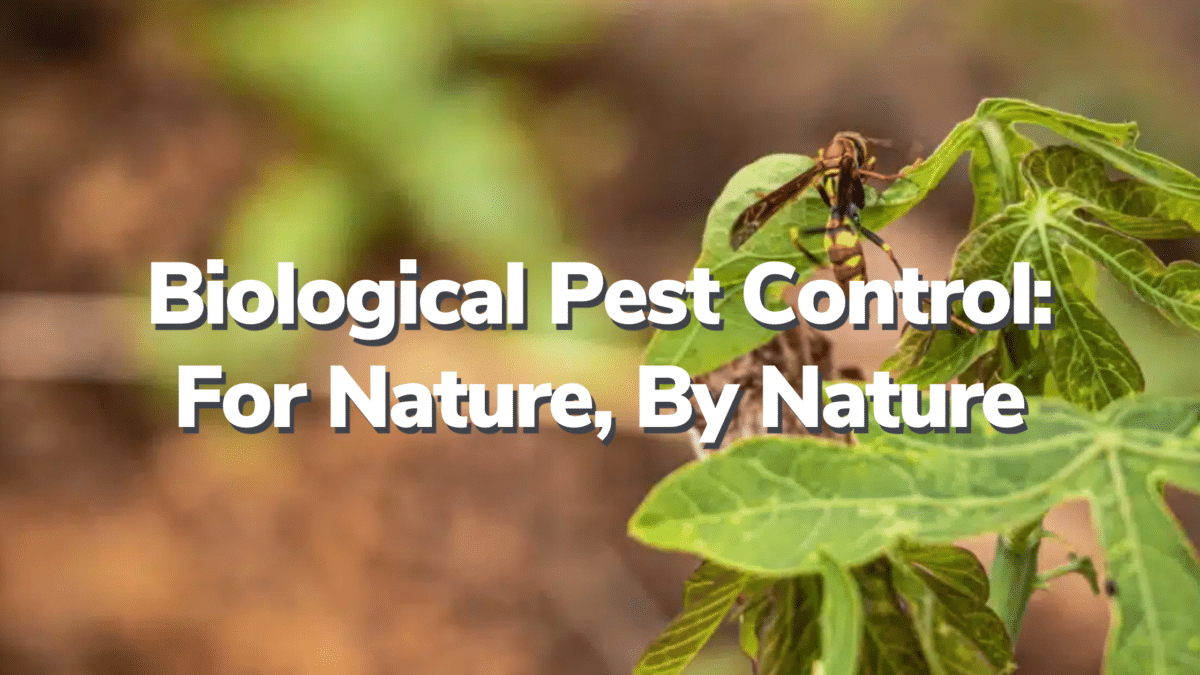Around the world, conventional products and chemicals intended to guard crops against disease, weed pressure and pests are increasingly falling out of favour due to the negative impacts they have on the natural environment, and even human health. So, what’s the alternative? Along with a focus on soil health and regenerative farming tactics, manufacturers and research institutions are working on developing and leveraging natural pest controls such as biologicals or bioproducts. Biological pest control uses other organisms to control pests such as insects and mites, and can even keep weeds and plant diseases at bay.
What is biological pest control?
Biological pest control is the use of a pest’s natural predators to control their populations, thus minimising their impact on economic and environmental practices. Biological methods of pest control are an alternative to pesticides and poisons. They rely on parasitism, predation, herbivory, and other natural mechanisms to reduce unwanted pests and diseases in an environment.
What’s the difference between biological pest control and organic pest control?
While both biological pest control and organic pest control aim to manage pests in an environmentally friendly manner, they differ in their specific approaches. Biological pest control primarily relies on natural enemies of pests, while organic pest control encompasses a broader range of natural or naturally derived substances and methods, adhering to organic farming principles.
What are the three biological methods of pest control?
- Conservation of existing natural enemies
- Classical biological control: introducing new natural enemies and establishing a permanent population
- Mass rearing and periodic release of biological control agents
What are bioproducts?
Bioproducts are naturally occurring living organisms and extracts of living organisms (including fungi, bacteria, nematodes, plants, insects, etc.) used to control pests and diseases, enhance crop growth, and protect plants and animals. There are two basic categories of bioproducts:
- Biocontrol agents: The use of living organisms (such as insects, bacteria and fungi) to control pest populations and ensure balance and equilibrium in the environment.
- Biostimulants: The use of products that stimulate and enhance the plant’s natural processes.
What are the 3 P’s of biological pest control?
Natural enemies of insect pests, also known as biological control agents, include predators, parasitoids, pathogens, and competitors.
- Predators: Predatory organisms are natural enemies of pests. They hunt, feed on, and reduce the populations of pest species. Examples of predators used in biological pest control include ladybugs, lacewings, predatory mites, and certain species of beetles.
- Parasitoids: Parasitoids are organisms that lay their eggs inside or on other insects, ultimately killing the host insect. They are often used to control pest populations by reducing their numbers. Parasitic wasps are a common example of parasitoids used in biological pest control.
- Pathogens: Pathogens are disease-causing organisms, such as bacteria, fungi, viruses, and nematodes, that infect and kill pests. Certain pathogens can be used as biological control agents to target specific pest species while minimizing harm to non-target organisms and the environment. For example, Bacillus thuringiensis (Bt) is a bacterium commonly used to control caterpillar pests in agriculture.
Predators
Many different kinds of predators feed on insects:
- Birds
- Amphibians
- Reptiles
- Fish
- Mammals
- Insect and other arthropod predators
Important insect predators include:
- Lacewings
- Lady beetles
- Hover flies
- Ground beetles
- Rove beetles
- Flower bugs
- Spiders
- Some families of mites
Parasitoids
Parasitoids are insects that have an immature stage in which they develop on or in a single insect host. This parasitic relationship ultimately kills the host. This is a highly specialised method of biological pest control since parasitoids are limited in their host range.
Pathogens
Bacteria, fungi, protozoans and viruses that cause disease in insects may impact the prevalence of pests by reducing their feeding and growing rates, slowing or preventing their reproduction, or killing them. Under certain environmental conditions, these diseases can multiply and spread naturally through an insect population.
Biological weed control agents include seed predators, herbivores, and plant pathogens.
What is an example of biological pest control?CASE STUDY: WASPS IN BRAZIL In Brazil, wasps are released into sugarcane fields by drones. Once in the area, they hunt down the eggs of the sugarcane borer, a moth with ravenous larvae that eat into the crops and profits of Brazilian farmers. The wasps parasitise the larvae so that when the eggs hatch, more wasps emerge as opposed to the borer’s progeny. This obliterates the pest population in the sugarcane. Once the pest numbers decrease, so do the populations of wasps. CASE STUDY: MOSQUITOES IN EDMONTON Instead of resorting to pesticides that impact the city’s food chain, water supply, and bird populations, the city of Edmonton in Canada recently voted to use biological pest control and education to combat mosquitoes. Since 1980, the city has dropped larvicide products from helicopters to target mosquito larvae. This year, however, they will change to biological pest control methods using dragonflies and bats. |
The benefits of biological pest control
By using biological macroorganisms or microorganisms, farmers can reduce (or even eradicate) the use of insecticide chemicals in their fields. Farmers using biological control of agricultural pests save on chemical inputs; consumers benefit from more natural produce. The impact of chemical spraying on local communities and the environment is reduced; and farmlands are maintained in a healthier condition.
Benefits of integrated pest management biological control include:
- Lack of toxicity
- Lower cost
- Lengthier protection
- High specificity
- Sequestration of inorganic nutrients
- Increased crop tolerance to various stressors, which is becoming more critical as climate change accelerates
- Better crop quality, vigour and yield
What are the disadvantages of biological pest control?
Despite the numerous benefits of biological control of agricultural pests, there are also some potential downsides:
- It’s hard to control: whatever natural enemy you set loose in an ecosystem may have ideas of their own and could go for something other than your intended target.
- It’s slow going: It takes time and patience for the biological pest control agents to have an impact on a pest population.
- The biological control of agricultural pests is more suited to controlling pest populations rather than completely wiping them out
- Although biological controls are cheaper in the long run, the initial planning and implementation of a successful system requires investment.
The biological pest control sector is booming
Europe is currently the largest biological pest control market with about 30% market share, followed by North America with about 24% market share. The global biological pest control market size is projected to reach USD 1440 million by 2027, up from USD 692.4 million in 2020. This represents a compound annual growth rate (CAGR) of 11% from 2021 to 2027.
This growth is a result of the increasing cost of chemical crop protection, concerns about excessive chemical use, and growing awareness of sustainable food production among consumers and producers. Another driver is the new technology available to deploy biocontrol measures, such as the drones used in Brazil.
Realising the shift in the market, even the big chemical companies are now investing in biologicals.
Although there is growing investment in biological controls worldwide, the sector is still facing obstacles to growth, particularly among rural, small-scale farmers who don’t necessarily have access to the technology, quality control, procedures and capital that go along with the widespread adoption of biological controls. But as increasing numbers of farmers understand the potential of biologicals, so will the barriers to adoption be eased.
Biological controls offer a sustainable tool to address farmers’ evolving needs to control pests and combat disease. Zylem products such as Sea Brix° and Amino K° are ideal in structured programmes incorporating crop protection products and crop nutrition for integrated pest management.
Get in touch with the Zylem team to find out more. Contact us on 033 347 2893 or send us an enquiry.

About the Author: Alex Platt
Alex is Business Development Manager at Zylem. He’s inspired by the potential of regenerative farming and takes a special interest in the technology and products that are moving agriculture in a more sustainable direction.

